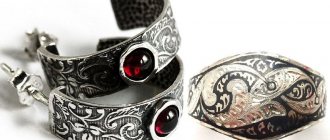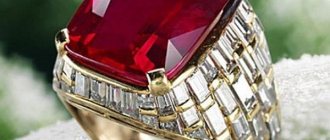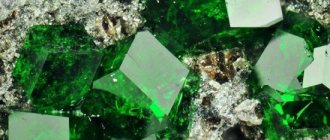The history of jewelry
Jewelry has always been in human life and has gone through its development path of a thousand years.
No one knows exactly when the first jewelry appeared. When carrying out various excavations, it turns out that jewelry dates back to the earliest eras in the development of mankind.
Shellfish shells were found in Morocco. They were thought to be part of a necklace that was approximately 110,000 years old. In Asia Minor, the remains of a woman who lived during the Paleolithic era were found. She wore a large number of beads and bracelets, so she can be considered a fashionable lady of that time.
Our ancestors decorated themselves with various objects: shells, flowers, fruit seeds, teeth, bones and even animal horns. The highest priority was given to stones processed by nature itself - quartz, silicon, jade, etc.
The first people to use jewelry were men. They wore them as amulets and amulets that protected from evil spirits. It was also possible to understand from the decorations who in the tribe was the leader, hunter or warrior.
Approximately five thousand years ago, the first jewelry appeared that was similar to what we now understand by this word. Egypt, Italy, China were the first to give modern people the opportunity to emphasize their beauty with the help of jewelry.
Gold, which is one of the most precious metals, marked the beginning of a new history and discoveries in jewelry.
In Ancient Egypt, gold processing became a craft, and goldsmiths began to appear.
They gave rise to the appearance of gold jewelry in the form of rings, chains, and bracelets. Craftsmen used stones such as turquoise, lapis lazuli, and chalcedony in their products. Also, in addition to external beauty, gold jewelry gave its owner a certain status and position in society.
In addition to the ancient Egyptians, the Incas in Peru and the Aztecs in Mexico also contributed to jewelry. Jewelry was also mentioned in the New Testament, where the kings of Judah wore gold bracelets as part of their clothing.
In ancient Rome, craftsmen decorated silver and gold items with precious stones such as diamonds. The upper strata of society wore jewelry made of gold, while city residents (merchants) wore jewelry made of silver. Slaves were also allowed to wear jewelry, but made of ordinary metal.
The Middle Ages is a new stage of development in jewelry. At that time in Europe, workshops for jewelry were located on the territory of monasteries. All efforts went into making religious objects.
During the Renaissance, jewelry making became one of the areas of artistic art. Famous artists of that time were also skilled jewelers.
The 17th – late 19th centuries are considered to be a real breakthrough in jewelry art. The products lost their symbolism and acquired the status of jewelry with decorative trim. The first schools of jewelry art began to open. At that time, jewelers were inspired by beautiful ladies to create their masterpieces. Of all the stones, preference is given to diamonds, which, one might say, become a symbol of every social event.
Baroque, Rococo, Classicism, Empire... These styles in art replaced each other, leaving behind such different, but equally magnificent jewelry, which captured not only the skill of the jewelers, but also the spirit of the era itself.
Jewelry has come a complex way from symbolic amulets and amulets to magnificent jewelry, from which we now take great pleasure.
Features of jewelry
Jewelry making is a special art in which a master, endowed with extraordinary talent, is able to transform expensive materials into works that have not only monetary, but also significant artistic value.
The most common materials used to create jewelry items include:
- precious metals (gold, silver and platinum);
- precious stones (diamonds, sapphires, emeralds, rubies, pearls);
- semi-precious stones (amber, turquoise, amethysts, topazes, opals).
All kinds of jewelry can be divided into the following main groups:
- elements of artistic decoration of bladed weapons and firearms;
- household items (book covers, vessels, dishes, boxes, watches, cases);
- items for religious purposes (crosses, reliquaries, frames for icons and sacred books, lamps, tabernacles, monstrances);
- items of faleristics and medallions (orders, medals, memorial signs);
- jewelry (bracelets, brooches, beads, chains, combs, tiaras, cufflinks, medallions, rings, necklaces, pendants, necklaces, rings, earrings, tiaras).
Master jewelers use a variety of techniques for artistic processing of metals and stones in their work, including:
- forging;
- casting;
- minting;
- embossing;
- carving;
- engraving;
- black;
- enamel;
- inlay;
- etching;
- rolling;
- polishing;
- grinding;
- cutting;
- bending;
- soldering;
- bartack
A unique feature of jewelry is the ability to reuse precious metals to produce items by melting down scrap. This often becomes the reason for the ruthless destruction of unique masterpieces discovered by treasure hunters and stolen by robbers.
Diamond Red Hancock
This small diamond has a very sharp purple-red color and weighs 0.95 carats. Due to such a rare color, a diamond increases in price several times. Even experienced jewelers consider it a great success if they come across such a diamond. The Red Diamond originally belonged to Mr. Hancock from Montana, who purchased it in 1956 for 13 and a half thousand dollars. The owner sold it in 1987 for approximately $150,000. This became a world record price per carat.
Relevant products in the Online store:
Lancaster
After Sun Tan Maximizer Legendary after-sun oil
RUB 1,299
Dr. Brandt
Eye contour cream with retinol and ruby crystals 24/7
RUB 3,048 RUB 4,690
Benefit
Benetint Liquid pigment for lips and cheeks ruby shade, miniature
899 rub.
exclusive bestseller
Therme
Heart of Holland Whipped body cream
from 559 rub.
All goods
La Peregrina
This pear-shaped pearl was found off the coast of Panama in 1576. Its weight is 202.24 carats. The pearl was purchased in Spain by Philip II in 1582. The royal crown was decorated with it. This crown belonged to eight generations of Spanish kings for 200 years. It later became the property of Joseph Napoleon Bonaparte, who was the elder brother of Napoleon Bonaparte and became King of Naples and Sicily. In 1969, it was purchased at a New York auction for 37 thousand dollars by Richard Burton. He brought the jewel as a gift to his wife Elizabeth Taylor for her 37th birthday. After some time, the pearl was placed in a necklace, which the actress wore to all public events. Peregrina was last sold at auction for $11,842,500. The Pearl of Peregrina is the most expensive gem sold at auction.
Modern Art
Nowadays, jewelry craft, perhaps even more than before, is becoming an art. Jewelry is a form of creative self-expression. Modern enterprises use more professional tools and affordable materials. However, many products are made from synthetic materials. And although they cannot surpass natural stones in beauty and perfection, they still compete with them with dignity.
Modern jewelry art worthily continues the traditions of the old masters. And the use of new technologies allows you to create more and more unusual and interesting jewelry.
Blue Oppenheimer
A blue diamond ring has become the most expensive piece of precious art ever sold. They paid $57,973,000 for it. The diamond received its name in honor of its owner, Sir Philip Oppenheimer. His family was involved in the diamond industry for many years. They could choose any diamond they liked. This stone was of an unusual color and had unusually perfect rectangular proportions. Blue diamonds are particularly popular due to their rarity. Oppenheimer Blue is classified as an "Uncommon Vivid Blue". It has the highest color gamut and color intensity among other blue diamonds. It is also the largest diamond to be offered for sale at auction. Its weight is 14.62 carats. This is truly a gem.
Mughal Spinel Necklace
This famous spinel necklace is engraved with the names of three Mughal emperors: Akbar, Jehangir and Shah Jahan. The Mughal dynasty ruled India for 332 years. During their reign, spinel was one of the most expensive and revered gems. This necklace was supposed to strengthen the immortality of the emperors. The spinel shade had a range of shades from dark red to pale pink. Spinel was usually used to make beads rather than cut them. The Persian ruler Nader Shah plundered the Mughal treasury. Very few decorations from that time have survived to this day. The Mughal necklace weighs 877.23 carats and is valued at $1,428,030.
The twentieth century
In the last century, a large number of trends were formed in jewelry. In the first decades, the dominant style was Art Nouveau. In jewelry art, his influence was realized in the extreme complexity of the forms and ornaments of jewelry. Platinum, palladium, and anodized aluminum are actively used. Diamonds are becoming popular again. Costume jewelry is also becoming fashionable, the distribution of which was significantly influenced by the famous Coco Chanel.
In the war and post-war years, products become simpler, gold is often replaced by bronze. In the second half of the century, under the influence of nonconformist ideas, craftsmen began to use unusual materials in their work, previously unthinkable for jewelry: wood, plastic, steel and others. With the development of complex technology, jewelry appears with chameleon stones that can change color depending on temperature changes or the mood of the owner. Cultured pearls of various colors are becoming popular.
During the Soviet years, Russian jewelry companies produced mostly mass products. But at the end of the last century, modern masters decided to revive the guild of Russian jewelers in order to return the art of jewelry to its former glory.
Antiquity
In ancient Greece, mentions of jewelry first appear in the middle of the second millennium BC. Jewelry was worn by both women and men. Ancient Greek men loved to decorate themselves with rings, bracelets, and pendants; women, in addition to rings, bracelets and earrings, loved to decorate themselves with elegant engraved brooches. Jewelry was made using pearls, amethysts, garnets, as well as glass and glaze. Beads, which were given various beautiful shapes, were especially popular. The treasure found by the German archaeologist Schliemann during the excavations of Troy in 1873 testifies to the high skill of ancient Greek jewelers. Among the items found were temple rings, neck torcs, hairpins, necklaces and exquisitely crafted tiaras.
The ancient Roman masters did not lag behind the ancient Greek masters. It was in Ancient Rome, as experts testify, that a new hitherto unknown type of jewelry appeared - brooches. Another innovation associated with ancient Rome is signet rings, which were used as a personal mark.








